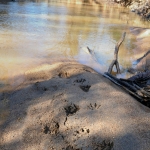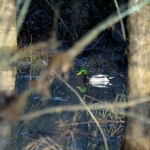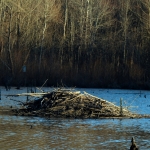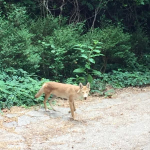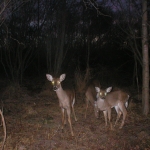At night, greenways become an I-85 for animals: Trail cameras reveal deer in small herds and sharp-snouted coyotes searching for food.
By Jack Horan
During the day, Four Mile Creek Greenway in Charlotte’s southeastern tip pulses with bicyclists, dog walkers and moms and dads pushing strollers along the wooded, paved trail and the wooden boardwalk that bridges wetlands thick with cattails.
This human hubbub for the most part keeps wildlife at bay except for the occasional startled deer or sun-seeking turtles that bask on logs in floodplain ponds.
But as dusk falls and the last of the day-use people have left, the greenway’s full-time residents emerge from hiding places to begin their nocturnal duties. Beavers gnaw on trees. Bullfrogs croak to warn rivals. Barred owls hoot “who-cooks-for-you, aww” in the tree canopy.
On summer evenings, the greenway becomes a leafy amphitheater to spot and listen to these night workers. That’s when Ginger White of Charlotte often joins a group of “frog walkers” wielding flashlights as they search for the amphibians beside the boardwalk.
Over the past five years or so, White said, she’s observed numerous frogs and toads, a barred owl with chicks and two beaver lumberjacks. “They were in the water chewing on a tree,” she said of the beavers.
Flashlights go off when darkness comes, so the group can watch firefly fireworks. “You look up and it’s like the whole sky is sparkling with lightning bugs,” White said. On the walks, “You never know what you’re going to see.
Mecklenburg County’s greenways are more than places to jog, bicycle or escape the hurly-burly of urban life. Their benefits go beyond recreation. They provide increasingly rare habitat for animals, birds and fish, refuges surrounded by urbanization. The forests, wetlands and grassy fields furnish sites for dens and foraging, protect water quality and aquatic life and, for night-time travelers like white-tail deer and coyotes, act as transit and dispersal corridors. At night, greenways become an I-85 for animals: Trail cameras reveal deer in small herds and sharp-snouted coyotes searching for food.
Mecklenburg’s greenway properties, including 16 developed greenways, cover more than 3,000 acres, an ever-growing system that ultimately will embrace 34 creek corridors. The county’s 2008 master plan update calls for 185 miles of trails, compared to 47 miles today. Geographically, greenways range from South Prong and West Branch Rocky River in Davidson in the county’s northeast corner to Six Mile Creek nestled against the Union County line near Ballantyne. Last year, total monthly visitation at greenways with counters peaked in October with 107,000, according to Mecklenburg County’s Park and Recreation Department.
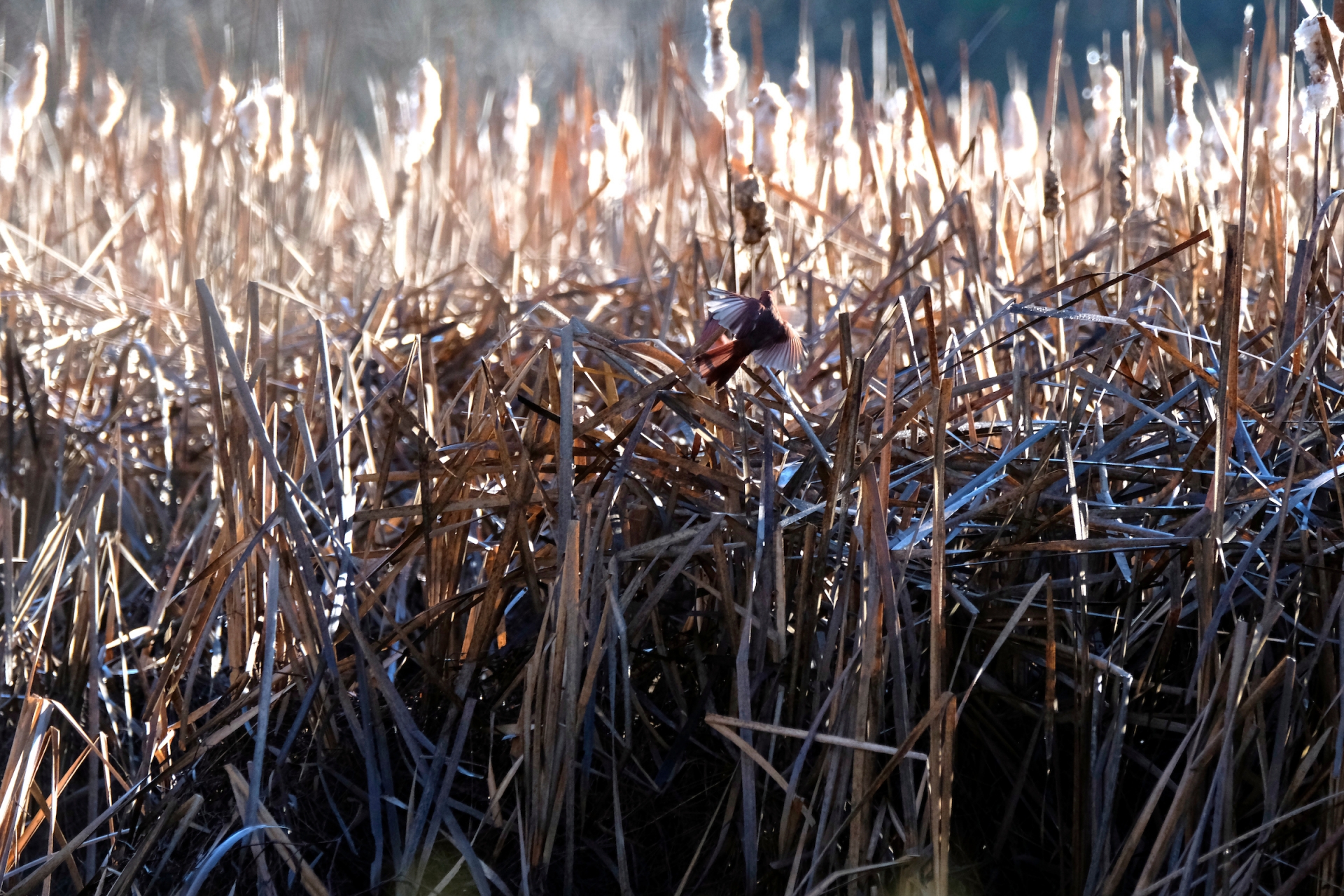
Some greenways – like Little Sugar Creek, a vibrant urban strand from Cordelia Park to Freedom Park to the Huntingtowne Farms neighborhood – contain modest habitat although Little Sugar Creek harbors a soft-shelled turtle species, ducks and owls.
Others span woods and waters. Three greenways – Mallard Creek, Clark’s Creek and Toby Creek – combine to make the longest contiguous trail system, extending 8.7 miles into the UNC Charlotte campus and west beyond I-85 into the Mallard Grove and Wellington neighborhoods. The combined trails give visitors an opportunity to see beavers, muskrats and deer.
Sometimes wildlife buffs must be satisfied with sounds, not sightings. In late January, traffic noise in parts of the Mallard Creek greenway was drowned out by the metallic trilling of tree frogs, celebrating the standing water from heavy rains.
But some greenways consist only of undisturbed habitat. An example is 123 acres acquired along Back Creek, north of Reedy Creek Park in northeastern Mecklenburg – no trails, no benches, no boardwalks. Some Back Creek properties will get a future trail, but others will remain undeveloped to protect water quality and preserve habitat, said Chris Matthews, Mecklenburg Park and Recreation’s division director for nature preserves and natural resources.
Matthews said the county typically allocates about $1 million a year to buy land for existing and future greenways.
“As we purchase land, along creeks and streams … there are times when we don’t put a trail down,” Matthews said. He said a trail could be several decades away, until the county has money to acquire enough land to make development feasible.
A third category of greenway properties are “DIRTways.” DIRTways are undeveloped greenways with temporary dirt paths, precursors to a developed trail. The county has three, including McDowell Creek near Torrence Creek greenways. “Properties will sit a long time before development,” Matthews said. “It could be 20 to 30 years before we acquire all the parcels.”
Matthews said acquired land varies in habitat quality, from cut-over pine plantations to farmland to forested stream sides. “We let nature do its thing,” he said, allowing woods to grow back.
For greenways with degraded streams, the job of restoring them falls to Charlotte-Mecklenburg Storm Water Services. Restoration can mean repairing what can be deep gullies with eroding banks, by stabilizing the channel, building in meanders and planting vegetation on the banks. Or, as with Little Sugar Creek, the restoration also created detention ponds to hold back and filter runoff. The adjacent greenway acts as a buffer to trap pollutants and reduce flood damage.
Storm Water Services recently restored more than 2 miles of McDowell Creek along the 1.5-mile-long segment of McDowell Creek Greenway at a cost of $2.5 million. Once a creek is restored, insects return, followed by fish and birds.
To thrive, animals must be able to move across the landscape. “Without protected forested travel corridors for wildlife, animals are isolated and biodiversity decreases,” the Mecklenburg’s 2016 State of the Environment Report notes. “McDowell Creek greenway corridor in the northwest part of the county is the only protected corridor to and from large protected public land, but even this area is only 6 miles in length and fragmented by roads.”
Mecklenburg deer populations have surged, coyotes have moved in and beaver have reclaimed former wetlands. But Matthews reports a decline of some natives such as foxes, otters and mink. Overall, he said, “The numbers of wildlife are going up. The animals are being concentrated in smaller areas.”
The wildlife haven embraced by Four Mile Creek Greenway lies between Rea Road and Johnston Road. It ties into the Lower McAlpine Creek and McMullen Creek greenways. The 5.8-mile-long trail, which passes under I-485 twice, is rimmed by a dynamic floodplain on one side and backyards on the other.
The naturalist who leads frog walks as well as owl prowls and bird walks along Four Mile Creek is Taylor Piephoff of Matthews. He said the wetlands support great blue herons, nesting prothonotary warblers (sometimes called swamp canaries due to their gaudy, yellow color) and migratory ducks such as mallards. Another migrant seen in winter is the rusty blackbird, a rapidly declining species that nests in the boreal forests of northern Canada and finds the swampy sliver to its liking.
Piephoff said the evening frog walks draw the biggest crowds, usually families with young children. He said resident bullfrogs, Southern leopard frogs and green tree frogs are easy to spot. He believes they spend the day safely reposing under the boardwalk. When the human parade fades at dusk, the amphibians take their cue and hop out.
“We actually catch frogs, examine the frogs, talk about frogs and let them go,” he said. “They come out on the woodland floor. Some nights we’ll see dozens and dozens of them.”
Jack Horan is a freelance writer specializing in outdoors, wildlife and conservation topics and is the retired outdoors editor of the Charlotte Observer. He regularly bikes Mecklenburg County greenways.
